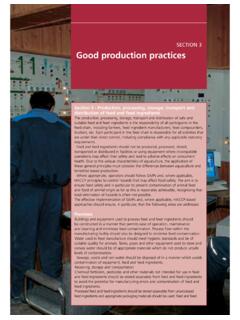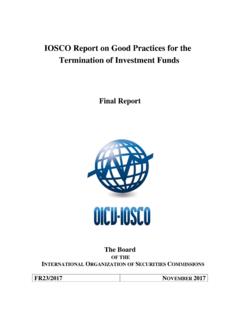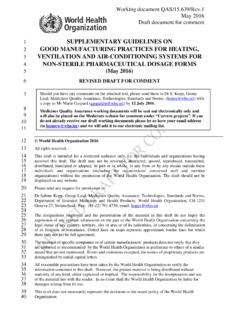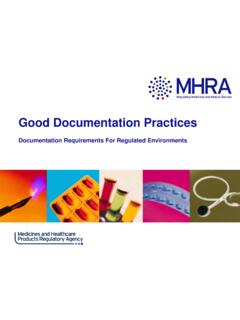Transcription of Annex 5 WHO good distribution practices for …
1 235 World Health OrganizationWHO Technical Report Series, No. 957, 2010 Annex 5 WHO good distribution practices for pharmaceutical products1. Introduction2. Scope of the document3. Glossary4. General principles5. Regulation of the distribution of pharmaceutical products6. Organization and management7. Personnel8. Quality system9. Premises, warehousing and storage10. Vehicles and equipment11. Shipment containers and container labelling12. Dispatch and receipt13. Transportation and products in transit14. Documentation15. Repackaging and relabelling16.
2 Complaints17. Recalls18. Returned products19. Counterfeit pharmaceutical products20. Importation21. Contract activities22. 11:042361. IntroductionDistribution is an important activity in the integrated supply-chain management of pharmaceutical products. Various people and entities are generally responsible for the handling, storage and distribution of such products. In some cases, however, a person or entity is only involved in and responsible for certain elements of the distribution process. The objective of these guidelines is to assist in ensuring the quality and identity of pharmaceutical products during all aspects of the distribution process.
3 These aspects include, but are not limited to, procurement, purchasing, storage, distribution , transportation, repackaging, relabelling, documentation and record-keeping storage, sale and distribution of pharmaceutical products are often carried out by various companies, institutions and individuals. This document sets out appropriate steps to assist in fulfi lling the responsibilities involved in the different aspects of the distribution process within the supply chain and to avoid the introduction of counterfeits into the marketplace via the distribution chain.
4 The relevant sections should be considered by various participants as applicable to the particular role that they play in the distribution of pharmaceutical nature of the risks involved is likely to be similar to that for risks encountered in the manufacturing environment, mix-ups, adulteration, contamination and cross-contamination. When the distribution chain is interrupted by manufacturing steps such as repackaging and relabelling, the principles of good manufacturing practices (GMP) should be applied to these pharmaceutical products are a real threat to public health and safety.
5 Consequently, it is essential to protect the pharmaceutical supply chain against the penetration of such products. Weak points in the distribution processes of pharmaceutical products provide an avenue for counterfeit as well as illegally imported, stolen and substandard medicines to enter the supply chain. This is a concern in both developed and developing countries. The methods by which such products enter the supply chain have become increasingly complex and have resulted in the development of thriving secondary and grey markets throughout the world.
6 The involvement of unauthorized entities in the distribution and sale of pharmaceutical products is a particular concern. Only a joint approach including all parties involved in the supply chain can be successful in the fi ght against counterfeit pharmaceutical products and, therefore, all parties active in the market should take an active part in collaborative models for the distribution of pharmaceutical products are used in different countries and sometimes within the same country, for example, 11:04237in the public and the private sector.
7 These guidelines are intended to be applicable to all persons and outlets involved in any aspect of the distribution of pharmaceutical products from the premises of the manufacturer of the product to the person dispensing or providing pharmaceutical products directly to a patient or his or her agent. This includes all parties involved in trade and distribution of medicines, pharmaceutical manufacturers, including the manufacturers of fi nished products and pharmaceutical wholesalers as well as other parties such as brokers, suppliers, distributors, logistics providers, traders, transport companies and forwarding agents and their relevant sections of these guidelines should also be considered for implementation by, among others, governments, regulatory bodies, international procurement organizations.
8 Donor agencies and certifying bodies, as well as all parties involved in any aspect of the trade and distribution of pharmaceutical products, including health care workers. The guidelines can also be used as a tool in the prevention of the distribution of counterfeit pharmaceutical products. It should, however, be noted that these are general guidelines which may be adapted to suit the prevailing situations and conditions in individual countries. National or regional guidelines may be developed to meet specifi c needs and situations in a particular region or maintain the original quality of pharmaceutical products, every party active in the distribution chain has to comply with the applicable legislation and regulations.
9 Every activity in the distribution of pharmaceutical products should be carried out according to the principles of GMP, good storage practice (GSP) and good distribution practice (GDP) as applicable. These guidelines do not deal with all aspects of the standards for the storage of pharmaceuticals which are covered in the WHO guide to good storage practices for pharmaceuticals (1). The dispensing to patients is addressed in the WHO good pharmacy practice (GPP) guide (2). These guidelines should also be read in conjunction with other WHO guidelines (3 6).
10 2. Scope of the documentThis document lays down guidelines for the distribution of pharmaceutical products. Depending on the national and regional legislation on pharmaceuticals, these guidelines may apply equally to products for human and for veterinary use. The guidelines thus cover products for which a prescription is required by the patient, products which may be provided to a patient without a prescription, biologicals and vaccines. Although medical devices are not included in the defi nition of pharmaceutical products for the purposes of this document, the main principles established in this document may also be used where applicable for medical 11:04238 The document does not specifi cally cover GMP aspects of fi nished products in bulk, distribution of labels or packaging, as these aspects are considered to be covered by other guidelines (3).















